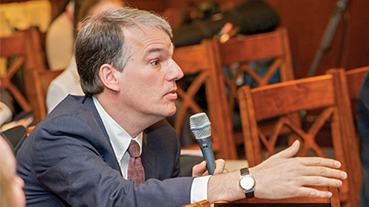Research Highlights: Targeting Challenges in Mental Health
Each and every day, NewYork-Presbyterian researchers and clinician-scientists are advancing knowledge in virtually every medical specialty. At Weill Cornell Medicine and Columbia University Vagelos College of Physicians and Surgeons, faculty are targeting some of today’s most formidable health challenges, pushing scientific discoveries forward and applying research breakthroughs to improving the lives of patients everywhere. In this issue of Advances, we share several of our recent investigations in behavioral health.
Online Databases: A Prescription for the Opioid Epidemic
Drug overdoses took the lives of some 64,000 Americans in 2016, a 22 percent rise over the previous year. The majority of these deaths were linked to opioids, including heroin, prescription painkillers, and the powerful synthetic drug fentanyl, which together killed more people than gun violence or even car accidents.
The growing crisis has alarmed officials at the highest levels, and in October, President Donald Trump directed the Department of Health and Human Services to declare the nationwide epidemic of opioid abuse a public health emergency. “It is a huge problem,” says Jonathan Avery, MD, Director of Addiction Psychiatry, NewYork-Presbyterian/Weill Cornell Medical Center, and an Assistant Professor of Clinical Psychiatry at Weill Cornell Medicine. “When I started here in 2009, it wasn’t even on many doctors’ radar.”
“Historically, there was no way for a physician to check to see if a patient had a history of being on the medication or was actively getting it from someone else.”
— Dr. Jonathan Avery
In recent years, however, New York City has seen a staggering number of fatal overdoses — nearly 1,400 in 2016, a 46 percent increase over the previous year, according to the city’s health department. Says Dr. Avery, “We’re seeing a lot of death everywhere.”
Tracking Prescriptions
Solutions have remained elusive, but according to Weill Cornell Medicine researchers, one of the most effective ways to prevent overdoses may be as simple as keeping better track of prescriptions. People who have developed opioid use disorders or are illicitly sharing pills with others often go to several doctors, either to get multiple prescriptions or to get a new prescription after being refused a refill. “Historically,” says Dr. Avery, “there was no way for a physician to check to see if a patient had a history of being on the medication or was actively getting it from someone else.” While some doctors may unscrupulously prescribe inappropriate drugs for profit, many well-intentioned practitioners are simply unaware that their patients have been prescribed opioids by another clinician.
But according to Yuhua Bao, PhD, Associate Professor of Healthcare Policy and Research, that is changing thanks to the advent of prescription drug monitoring programs. With these statewide online databases, pharmacies are required to log each opioid prescription they fill, and physicians and pharmacists can check whether a particular patient has already been prescribed one by another practitioner. Forty-nine states (all except Missouri) and the District of Columbia now have such programs — up from 11 in 2003, the year the federal government began offering grants to fund them.
Dr. Bao has spent the past few years studying the effectiveness of these programs. In 2016, she led a team that found that when a state creates one, it lowers the likelihood that a pain patient will be prescribed Schedule II opioids (a category that includes Percocet and OxyContin) by 30 percent, a result that Dr. Avery, who was not involved with Dr. Bao’s study, says demonstrates their “huge” potential to curb addiction. While it is not clear that all the eliminated prescriptions would have been unnecessary, Dr. Bao says, it does indicate that monitoring programs make doctors more circumspect about prescribing the most addictive drugs.
“We found the effect of a state implementing a monitoring program to be immediate,” Dr. Bao says of the work, published in 2016 in the journal Health Affairs. “It might be because of rising awareness of an opioid misuse problem, or because physicians feel like they’re being watched.”
In some states, physicians’ use of databases is voluntary, while in others, doctors have a legal obligation to at least register with the system. In a 2017 study, also published in Health Affairs, Dr. Bao and colleagues reported that the requirement simply to register can trigger a drop of as much as 10 percent in the number of opioid prescriptions filled by Medicaid patients, presumably by raising physicians’ awareness of the monitoring system and the potential for drug misuse.
That 2017 study relied on 2011-2014 data from the Centers for Medicare and Medicaid Services, which covers a population that is especially vulnerable to opioid misuse and overdose. The reasons for this are complex, but one is that lower-income people often work physical jobs that are more likely to cause injury, which in turn can lead to chronic pain conditions for which doctors may prescribe opioids. Once Medicaid patients receive a prescription for opioids, they may also be more likely to misuse them, a risk factor linked to the tendency of less affluent people to suffer from more life stressors.
Some of Dr. Bao’s future work on drug monitoring programs will involve exploring their potential pitfalls. These include the worry that if doctors fear they’ll face negative consequences for prescribing opioids even if patients genuinely need them, they may opt not to prescribe them at all. Also, limiting access to prescription opioids may lead individuals to turn to even more dangerous street drugs, including heroin and fentanyl.
Dr. Bao will also study ways to make monitoring programs more effective, including by sharing data across state lines. “This is especially salient to places like New York City,” she explains, “where you may also have patients from New Jersey or Connecticut.” And she notes that in addition to saving lives, databases could also reduce costs: The 2017 study found that if every state mandated that prescribers register with the system, Medicaid would save more than $166 million a year.
Source: Weill Cornell Medicine
Reference Articles
Bao Y, Wen K, Johnson P, Jeng PJ, Meisel ZF, Schackman BR. Assessing the impact of state policies for prescription drug monitoring programs on high-risk opioid prescriptions. Health Affairs (Millwood). 2018 Oct;37(10):1596-1604.
Bao Y, Pan Y, Taylor A, Radakrishnan S, Luo F, Pincus HA, Schackman BR. Prescription drug monitoring programs are associated with sustained reductions in opioid prescribing by physicians. Health Affairs (Millwood). 2016 Jun 1;35(6):1045-51.
Related Publications

Opioid Overdose Survivors Face Higher Death Rate








